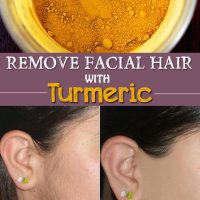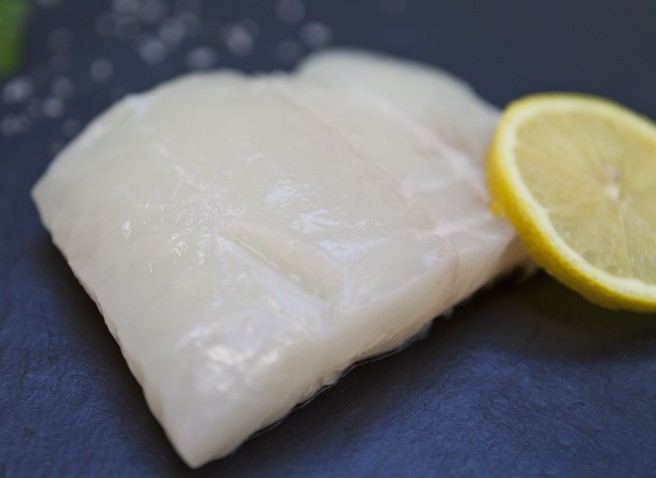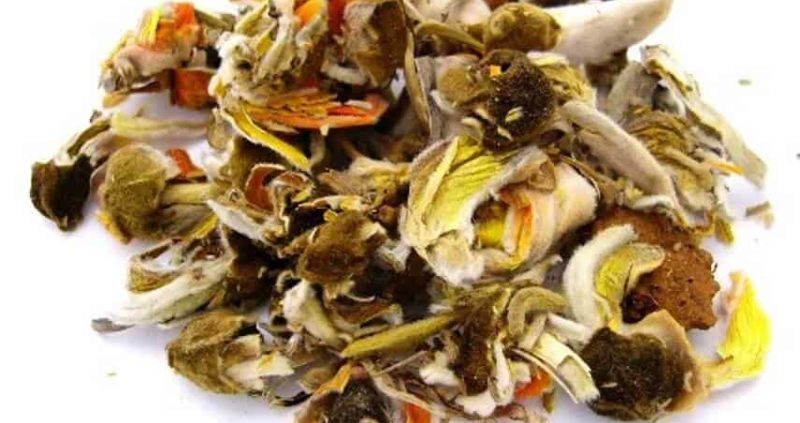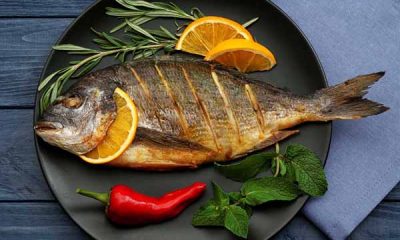Health
How to remove facial hair with turmeric

Why and how to use turmeric to remove facial hair?
This turmeric never ceases to amaze us, and if it doesn’t, it will be after reading this article. Indeed, we are going to see how and why to use turmeric to fight against unwanted facial hair.
I suggest here some methods, soft or strong, with different levels of effectiveness, to eliminate those hairs that annoy you! They are effective for the face, but also, of course, for the whole body!
<img class="i-amphtml-intrinsic-sizer" style="box-sizing: border-box; max-width: 100%; display: block !important;" role="presentation" src="data:;base64,” alt=”” aria-hidden=”true” /><img class="i-amphtml-intrinsic-sizer" style="box-sizing: border-box; max-width: 100%; display: block !important;" role="presentation" src="data:;base64,” alt=”” aria-hidden=”true” />
Overview:
It is a predominantly female concern, with every woman wishing to have a radiant face and, at a minimum, without any hair. To do this, they practice waxing, hair removal with thread, tweezers, or they use dyes, in short: they struggle!
The abnormal growth of hair, hirsutism in medical terms, often happens to women with dark hair, because even if all women are hairy, in them it is more visible. So that can become an embarrassing problem, especially as they get older and their estrogen levels drop.
There are many natural, inexpensive, and good facial methods to get rid of unwanted facial hair, and that’s thanks to turmeric, a perfect ingredient for external use. Turmeric is also used to have beautiful skin.
These recipes allow either permanent hair removal, or in the medium term allow hair to be refined, bleached, or prevent regrowth. In any case, they leave the skin of the face healthy, soft, without blackheads and above all: without hair!
Turmeric will act on 4 levels: hair removal, hair colouring, hair thickness, slowing down or even stopping hair regrowth. Well, more should be said about these methods:
A permanent hair removal mask? Yes for some and no for others.
Hair removal or a mask? Both my captain.
Hair removal in one application? No! As I will specify later, it must be applied 2 or 3 times a week for one or two months to have a concrete result.
In all the methods that we are going to see, do not put the mask or the balm on the eyebrows, that goes without saying, but I prefer to specify!
Recipes of turmeric depilatory masks:
Turmeric and chickpea flour:
Effective for both light hair and thick hair, this is my favourite gentle method, a traditional Indian method.
Chickpea flour is traditionally used in India in combination with turmeric to suppress and prevent hair growth all over the body.
Women are used to using this method on themselves, but also on children to keep their skin soft, clean and hairless.
Ingredients :
1/2 bowl of chickpea flour
1/2 bowl of milk
1 heaped teaspoon of ground turmeric
1 teaspoon of fresh cream
Preparation :
Mix the turmeric and the chickpea flour, then mix with the milk and the fresh cream until you obtain a homogeneous and smooth paste.
Apply liberally to the face in the direction of hair growth, until the preparation covers all the hair.
Leave the mask on for 30 minutes, then rub the face with your hands or a slightly moistened glove, against the grain.
Then finish rinsing your face so as not to leave yellow marks.
This method should be repeated at least 2 or 3 times a week, for at least 1 or 2 months, before you see any obvious effect.
In the long term, it will allow a decrease in hair growth, a decrease in thickness, until total disappearance.
Turmeric, honey and lemon juice:
Effective on fine hairs by exfoliating effect, lemon cleanses and gum, and honey helps to soften the hairs. They both slow down hair growth, and “colour”, or rather whiten hair.
<img class="i-amphtml-intrinsic-sizer" style="box-sizing: border-box; max-width: 100%; display: block !important;" role="presentation" src="data:;base64,” alt=”” aria-hidden=”true” />
It is a remedy widely used in Egypt.
Ingredients :
4 tablespoons of honey
1 tablespoon of lemon
1 teaspoon of turmeric
Preparation :
Mix all the ingredients and apply to the face. Leave on for 20 minutes then rub with a glove and rinse with fresh water.
This method should be repeated at least 2 or 3 times a week, for at least 1 or 2 months, before you see any obvious effect.
In the long term, it will allow a decrease in hair growth and a decrease in thickness.
Turmeric and red lentils
Also thanks to its exfoliating and exfoliating effect, a mask with red lentils (masoor dal in Indian) is ideal for getting rid of hair. It is a mask used in India to purify and remove hair from the whole body.
Ingredients :
2 tablespoons of red lentils
1 or 2 tablespoons of almond milk
1/2 teaspoon of turmeric
Preparation :
Mix the red lentils until you obtain a fine powder, and mix this powder with the turmeric, pour in the milk and mix until you obtain a very smooth paste.
Apply the paste on the face, leave to act for 20 min then rub with the hands or a glove.
This method should be repeated at least 2 or 3 times a week, for at least 1 or 2 months, before you see any effect.
Turmeric and wheat flour
Ingredients :
1 teaspoon of turmeric
1 teaspoon of wheat flour
olive oil
Preparation :
Mix the flour and turmeric. Pour in the olive oil very slowly while mixing until you get a thick paste.
Apply on your face and let sit for 30 min.
Remove by rubbing with your hands or a glove.
You will have noticed that all these methods are more or less the same, you can vary them, use other ingredients for the skin like rose water or orange blossom water.
Honey, turmeric and milk: one of the remedies for facial hair!
The harsh, but very effective methods:
Why hard method? Because these are recipes for preparing depilatory waxes, so you will have to remove the wax with a snap to depilate the hair and that: it stings!
Turmeric and egg white:
It’s a recipe that comes to me from a market client, tested by my wife who approved it 100%!
Ingredients :
1 egg white
1 teaspoon of turmeric
1 teaspoon of flour
Preparation :
Mix all the ingredients to obtain a mixture neither too liquid nor too thick, otherwise, add dry ingredients to thicken it, a little water to liquefy it.
Spread the mask liberally on the face and put toilet paper on top.
Leave to dry for 30 minutes, and once dry and hard, pull sharply against the grain. Finish by rinsing with fresh water.
Turmeric and sugar
Simple, fast and effective. Sugar has always been used as a natural treatment for hair removal in Egypt. Unlike conventional hair removal, you have to pull the hairs in the direction of the hair growth, it hurts less and irritates the skinless.
Ingredients :
2 teaspoons of powdered sugar
1 teaspoon of honey
1 teaspoon of water
1 or 2 knife tips of turmeric
Preparation :
Mix the sugar and turmeric, then mix the mixture with the honey and water.
Heat the mixture for about 30 seconds in the microwave, until it boils and browns.
Mix, and let cool so as not to burn your skin. Apply the wax with a spatula on the areas to be depilated.
Place a strip of fabric on the wax, smooth with your fingers in the direction of the hair, and tear in the direction of the hair growth.
Variation: same recipe, but with 1/4 cup of water, 2 cups of powdered sugar and 1/4 cup of lemon juice, heat in a saucepan until boiling, then 25 min over low heat at a simmer until it reaches a dark amber colour.
Health
Managing Chronic Pain: Integrative Techniques for Wellness

Key Takeaways
- Understanding chronic pain and its various treatment options is essential for effective management.
- Lifestyle factors, including diet, exercise, and sleep, can significantly influence chronic pain.
- Integrative techniques, including medical treatments and complementary therapies, are vital in tackling pain holistically.
Understanding Chronic Pain
Chronic pain is a persistent type of pain that can last for months or years and may be caused by various factors. In contrast to acute pain, it can continue even after the original injury has healed. Healthcare professionals evaluate a patient’s self-reported pain level and the impact it has on their daily activities to address the complexity of chronic pain. When the underlying cause is unknown, multidisciplinary approaches are necessary to relieve pain.
The Role of Lifestyle in Chronic Pain Management
In the quest for relief, many find solace in discovering a reputable pain clinic near me that employs a range of treatment options. Diet and chronic pain have a significant, if not entirely understood, relationship. Pro-inflammatory foods, excessive caffeine, alcohol, and refined sugars tend to exacerbate inflammation, potentially intensifying pain. On the other hand, anti-inflammatory foods such as fatty fish, greens, nuts, and seeds may help reduce inflammation and, as a result, pain. Consistent hydration and balanced meals can support the body’s natural coping mechanisms. Creating a personalized diet plan with a nutritionist or dietician can be a proactive step in managing chronic pain through lifestyle. Being physically active is critical to managing chronic pain.
Medical Treatments for Chronic Pain Relief
Medications often serve as the first line of defense in chronic pain management. NSAIDs, for example, are commonly used to alleviate inflammation and pain. Antidepressants and anticonvulsants can also be prescribed for their pain-relieving properties. Caution must be taken, especially with more robust, potentially habit-forming medications such as opioids; these should only be used when necessary and with a strict plan for monitoring and tapering. Furthermore, patients are encouraged to ask their healthcare providers about potential side effects and interactions with other medications.
Beyond pharmacological measures, interventional treatments like nerve blocks, epidural steroid injections, and radiofrequency ablation offer non-surgical pain relief for various conditions. In some cases, these targeted procedures may provide lengthy periods of relief and help patients engage in physical therapy and rehabilitation more effectively.
With chronic pain being such a dynamic and individualized issue, research into new therapeutic methods is ongoing. Treatments such as platelet-rich plasma therapy (PRP) and stem cell injections are emerging as potential alternatives. They focus on repairing damaged tissues and reducing pain naturally. However, consulting with experienced pain management specialists before considering these advanced options is essential.
Psychological Approaches to Pain Management
Chronic pain has deep psychological and emotional roots in addition to physical causes. Therapies like Cognitive Behavioral Therapy (CBT) address the thought patterns that can worsen pain perception and decrease the quality of life. Patients can learn to change these thoughts, engage in positive behaviors, and develop strategies to manage setbacks in their pain journey. Biofeedback is a technique that measures and provides real-time data on bodily functions, such as heart rate, muscle tension, and skin temperature. It helps patients gain voluntary control over these functions, and mastering such autonomic processes can improve pain management and give a greater sense of personal power.
Emotional well-being is integral to pain management, as negative emotions can intensify pain perception. Healthcare providers may recommend therapy sessions to address the psychological impacts of chronic pain, helping individuals cope with associated feelings of frustration, depression, or isolation. These therapeutic approaches highlight the importance of treating chronic pain as a comprehensive, biopsychosocial condition.
Navigating the Healthcare System
The complexity of healthcare systems can add a layer of stress for those managing chronic pain. Advocacy is critical. Patients must feel empowered to ask questions and make informed decisions regarding their care. Understanding how health insurance works, what treatments are covered, and how to access necessary medications is imperative. Healthcare professionals can also be invaluable allies in helping patients navigate these systems and ensure that they receive appropriate and timely care.
Looking Ahead: The Future of Pain Management
As we learn more about pain, there is hope for better pain management through new treatments and technologies. For example, virtual reality therapies can help distract patients from pain and reduce its intensity by immersing them in relaxing environments. Scientists are also exploring innovations in pharmaceuticals, non-invasive brain stimulation techniques, and cognitive behavioral therapy apps to treat chronic pain more effectively. Additionally, personalized medicine, which considers an individual’s genetic makeup, lifestyle, and environmental factors, is set to revolutionize pain management.
Health
10 shocking health benefits of eating white fish

Table of Contents
Health
5 Health benefits of butea superba and side effects

Table of Contents
-

 Food2 months ago
Food2 months ago8 shocking benefits of leek juice and side effects
-

 Food1 month ago
Food1 month ago10 + Benefits of carrot juice and side effects
-

 Health1 month ago
Health1 month agoBenefits of guava leaves Sensually
-

 Health2 months ago
Health2 months ago10 shocking health benefits of Canary seed milk
-
Weight Loss1 month ago
Chrissy Metz Weight Loss Secret (2022)
-

 Health1 month ago
Health1 month ago7 health benefits of cashew leaves and side effects
-

 Weight Loss1 month ago
Weight Loss1 month agoKelly Osbourne weight loss 2022
-

 Food2 months ago
Food2 months agoHealth benefits of gongolili or vetiver and side effects












